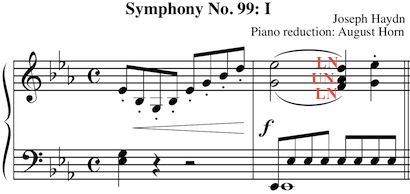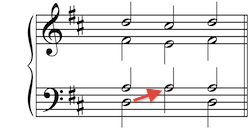
HARMONIC EXPANSIONS
CHAPTER 1: EXPANDING THE TONIC TRIAD; THE FUNDAMENTAL HARMONIC PROGRESSION
1.2 Expanding the tonic triad with lower neighbors
 |
 |
 |
 Franz Joseph Haydn, "Papa" Haydn, was known for his musical humor and wit.
Franz Joseph Haydn, "Papa" Haydn, was known for his musical humor and wit. |
 |
In his Symphony No. 99 Haydn expanded a tonic triad by inserting notes not belonging to the chord--see the top staff of measure 2 above. In this measure the pervading E-flat harmony is expanded on beat 3 by stepwise movement in the top voice from E-flat to D and back to E-flat. (As we shall see a triad with a missing fifth--as in these E-flat chords--is not uncommon). Also, the G goes both up and down by step to A-flat and F before returning to G. The notes which do not belong to the overall E-flat harmony are called embellishing tones in this chapter. Specifically, the embellishing tones D and F are called lower neighbors (LN in the score) and the A-flat is an upper neighbor (UN).
|
|
|
| To continue the kind of expansions used in these web pages, the bass rises to the fifth of the tonic triad when the upper and lower neighbors appear. The tonic embellishment of the bass rising to the fifth does not appear in the Haydn example at the top of the page. Instead see the illustration to the right where the bass rises to A and then returns to D. PLAY the complete expansion below. |
 |
|
Arabic numerals, or figured bass numerals, are numbers below the staff which indicate intervals above the bass, often with the addition of one or more octaves. See the numbers in the video on the left. The familiar 5/3, 6, and 6/4 are examples of Arabic numerals which identify a chord as root position or inverted. See the 5/3 by the Roman numeral I under the first measure. Remember from Chapters 13 and 14 of the Fundamentals Workbooks that these numbers do not specify the voice in which the higher notes appear. Lines between two Arabic numerals show that they refer to the same voice. So far in these four part voice leading examples, lower neighbors only embellish notes of a tonic triad which are a third and an octave above the bass. The fifth does not move. Notice that the rising bass produces a 5/3 chord in the last measure. |
|
Your turn! WRITE a tonic expansion. 1. Download and print pdf file 01.2. 2. Write an expansion of a tonic G minor triad with paper and pencil on your printout. Use the expansion of D Major, above, as a model. 3. ENTER, PLAYBACK and possibly TURN IN the expansion you just wrote using the online notation program, Noteflight. [Instructors: students can work online and then email you a web address (URL) of their completed assignment. See the "Sharing" tab on the right of Noteflight pages] a. Sign up for a free membership to Noteflight. b. Go to the online file named Harmonic Expansion 1.2. c. Enter your notes. You will need the "Use Upper (or Lower) Voice" command under the Staff Menu. If you need help with Noteflight see their help page . d. If requested by your instructor, CLICK the "sharing" tab on the right and TURN IN a web address for your work. |
 |
 |
 |
 |
 |
Comments? Click here. |



